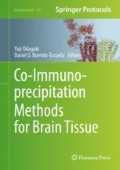Abstract
Protein complexes are responsible for major biological processes in cells. Identifying a protein’s interaction partners reveals many different aspects related to the target such as its function, regulation, and mechanisms of action. Co-immunoprecipitation (co-IP) followed by shotgun proteomics is a powerful technique for capturing and identifying endogenous protein complexes. Although it is a simple concept, performing the experiment can be challenging due to the number of steps and the diversity of available protocols. Here we present a certified and detailed protocol to perform co-IP experiments in cultured human oligodendrocytes cells.
Access this chapter
Tax calculation will be finalised at checkout
Purchases are for personal use only
References
Sevimoglu T, Arga KY (2014) The role of protein interaction networks in systems biomedicine. Comput Struct Biotechnol J 11(18):22–27. https://doi.org/10.1016/j.csbj.2014.08.008
Furlong LI (2013) Human diseases through the lens of network biology. Trends Genet 29(3):150–159. https://doi.org/10.1016/j.tig.2012.11.004
Lovestone S, Killick R, Di Forti M, Murray R (2007) Schizophrenia as a GSK-3 dysregulation disorder. Trends Neurosci 30(4):142–149. https://doi.org/10.1016/j.tins.2007.02.002
Tourette C, Li B, Bell R, O’Hare S, Kaltenbach LS, Mooney SD, Hughes RE (2014) A large scale huntingtin protein interaction network implicates Rho GTPase signaling pathways in Huntington disease. J Biol Chem 289(10):6709–6726. https://doi.org/10.1074/jbc.M113.523696
Song C, Shieh CH, Wu YS, Kalueff A, Gaikwad S, Su KP (2016) The role of omega-3 polyunsaturated fatty acids eicosapentaenoic and docosahexaenoic acids in the treatment of major depression and Alzheimer’s disease: acting separately or synergistically? Prog Lipid Res 62:41–54. https://doi.org/10.1016/j.plipres.2015.12.003
Cassoli JS, Guest PC, Malchow B, Schmitt A, Falkai P, Martins-de-Souza D (2015) Disturbed macro-connectivity in schizophrenia linked to oligodendrocyte dysfunction: from structural findings to molecules. NPJ Schizophr 1:15034. https://doi.org/10.1038/npjschz.2015.34
Tkachev D, Mimmack ML, Ryan MM, Wayland M, Freeman T, Jones PB, Starkey M, Webster MJ, Yolken RH, Bahn S (2003) Oligodendrocyte dysfunction in schizophrenia and bipolar disorder. Lancet 362(9386):798–805. https://doi.org/10.1016/S0140-6736(03)14289-4
Cudrici C, Niculescu T, Niculescu F, Shin ML, Rus H (2006) Oligodendrocyte cell death in pathogenesis of multiple sclerosis: protection of oligodendrocytes from apoptosis by complement. J Rehabil Res Dev 43(1):123–132
Miyata S, Hattori T, Shimizu S, Ito A, Tohyama M (2015) Disturbance of oligodendrocyte function plays a key role in the pathogenesis of schizophrenia and major depressive disorder. Biomed Res Int 2015:492367. https://doi.org/10.1155/2015/492367
Martins-de-Souza D (2011) Proteomics as a tool for understanding schizophrenia. Clin Psychopharmacol Neurosci 9(3):95–101. https://doi.org/10.9758/cpn.2011.9.3.95
Free RB, Hazelwood LA, Sibley DR (2009) Identifying novel protein-protein interactions using co-immunoprecipitation and mass spectroscopy. Curr Protoc Neurosci Chapter 5:Unit 5.28. https://doi.org/10.1002/0471142301.ns0528s46
Markham K, Bai Y, Schmitt-Ulms G (2007) Co-immunoprecipitations revisited: an update on experimental concepts and their implementation for sensitive interactome investigations of endogenous proteins. Anal Bioanal Chem 389(2):461–473. https://doi.org/10.1007/s00216-007-1385-x
Eng JK, McCormack AL, Yates JR (1994) An approach to correlate tandem mass spectral data of peptides with amino acid sequences in a protein database. J Am Soc Mass Spectrom 5(11):976–989. https://doi.org/10.1016/1044-0305(94)80016-2
Eng JK, Jahan TA, Hoopmann MR (2013) Comet: an open-source MS/MS sequence database search tool. Proteomics 13(1):22–24. https://doi.org/10.1002/pmic.201200439
Hong Ji, (2010) Lysis of Cultured Cells for Immunoprecipitation. Cold Spring Harbor Protocols 2010 (8):pdb.prot5466
Edgar Nägele, Martin Vollmer, Patric Hörth, Cornelia Vad, (2014) 2D-LC/MS techniques for the identification of proteins in highly complex mixtures. Expert Review of Proteomics 1 (1):37–46
Inez Finoulst, Martijn Pinkse, William Van Dongen, Peter Verhaert, (2011) Sample Preparation Techniques for the Untargeted LC-MS-Based Discovery of Peptides in Complex Biological Matrices. Journal of Biomedicine and Biotechnology 2011:1–14
Acknowledgments
Research was funded by FAPESP (São Paulo Research Foundation, grants 2016/18715-4 and 2016/07948-8).
Author information
Authors and Affiliations
Editor information
Editors and Affiliations
Rights and permissions
Copyright information
© 2019 Springer Science+Business Media, LLC, part of Springer Nature
About this protocol
Cite this protocol
Smith, B., Martins-de-Souza, D., Fioramonte, M. (2019). Using Co-immunoprecipitation and Shotgun Mass Spectrometry for Protein-Protein Interaction Identification in Cultured Human Oligodendrocytes. In: Odagaki, Y., Borroto-Escuela, D. (eds) Co-Immunoprecipitation Methods for Brain Tissue . Neuromethods, vol 144. Humana Press, New York, NY. https://doi.org/10.1007/978-1-4939-8985-0_4
Download citation
DOI: https://doi.org/10.1007/978-1-4939-8985-0_4
Published:
Publisher Name: Humana Press, New York, NY
Print ISBN: 978-1-4939-8984-3
Online ISBN: 978-1-4939-8985-0
eBook Packages: Springer Protocols

